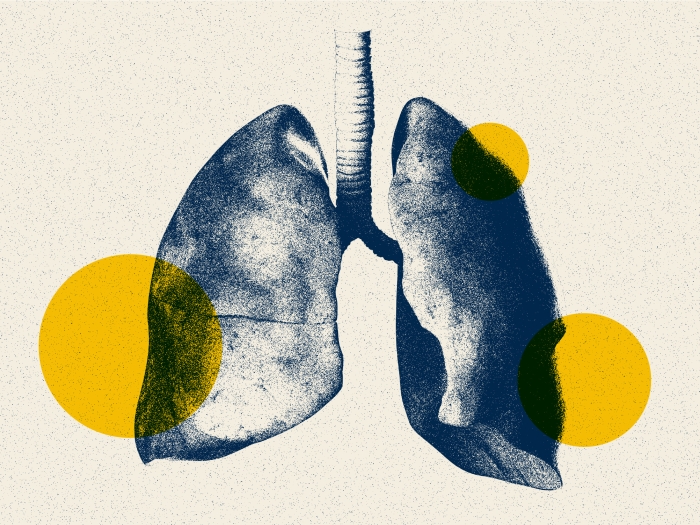This Global Pulmonary Fibrosis Awareness Month, U-M patient Larry Sims is building awareness via online support groups, signage on his truck and a new proclamation from the state.
7:00 AM
Author |

Larry Sims knows the importance of taking care of his idiopathic pulmonary fibrosis, which he's had since 2014.
"There's no cure for pulmonary fibrosis," he says. "So I just take my medication, which seems to be working and holding me steady, and hope it continues to slow the progression."
SEE ALSO: How to Reduce the Risk of DVT While Traveling
Pulmonary fibrosis occurs when the tissue deep within the lungs becomes thick and scarred over time, leaving the lungs unable to properly deliver oxygen to the body. Symptoms of the disease include cough, shortness of breath and fatigue. Sims' case is idiopathic, meaning doctors can't find a specific cause for the disease.
Sims decided to visit a local pulmonologist after his father recently died of lung disease. After initial investigation, his pulmonologist referred him to a surgeon to consider a lung biopsy.
"The surgeon said there was enough evidence on the CT scan and no need for a biopsy," Sims says. "The CT scan was definitely visibly showing what was going on. My lung was already honeycombed and scarred."
Sims' surgeon referred him to Kevin Flaherty, M.D., a professor in the Division of Pulmonary and Critical Care Medicine at the University of Michigan, for a second opinion. Dr. Flaherty agreed that Sims' diagnosis was idiopathic pulmonary fibrosis.
"When I was officially diagnosed, I about lost it," Sims says. "I thought you have to be kidding me. Dr. Flaherty asked me if I knew what the disease was, and I said yes, my father passed away from it. I just kept thinking this is not going to be good."
"Some cases of pulmonary fibrosis are genetic, but most seem to be sporadic," Flaherty says. "We diagnose it as idiopathic unless there seems to be a very strong family history of the disease. And even within families, we often don't know the genetic defect or how a defect may lead to the fibrosis. It's an area of intense research."
Sims says he started doing research immediately and got involved in online worldwide support groups.
"We share our knowledge and stories, and it seems to help me a lot," he says.
Sims noticed he was becoming depressed after the diagnosis, but he decided he wasn't going to let the disease control his life.
"It was hard for me to talk about it at first, but the more I'm involved now, the more it helps me."

A fight for funding
Sims builds awareness for his disease throughout the year, but he steps it up in September: Global Pulmonary Fibrosis Awareness Month.
SEE ALSO: 6 Things You Need to Know About Pneumonia
"This year I got some great signs from the Pulmonary Fibrosis Foundation, and I made them magnetic and stuck them on the outside of my pickup truck," he says. "Blue is the disease's awareness color, and I wear blue every single day of the month."
Then, Sims got an idea from his fellow online support group members.
"People were posting how they got a proclamation for the disease in their state, and I thought, 'I'm going to go on the state government website and see if anyone did it for Michigan.'" Proclamations are issued by state governors' offices to increase awareness of issues affecting citizens throughout their states.
After noticing no one had, Sims talked to his wife, Sheryl, about his plan.
"She works for the Lapeer County Courthouse, so I got everything together and I asked the commissioner from Lapeer County to help me put it all together for submission," Sims says.
Sims received the proclamation in early September and couldn't be prouder.
"The governor signed it, and I've been showing it off everywhere I go," he says. "My wife is very proud of me, and I like to share about the disease because how are you going to spread awareness without letting everyone know?"
Sims says he acts because he believes in the need for more funding for research and better cures for the horrific disease.
"The [state] representative from Lapeer County is going to be going to Lansing soon to try to get some more funding for pulmonary fibrosis research in Michigan. I'm excited about that."
"Pulmonary fibrosis research is clearly needed to find a cure for this disease," Flaherty says. "Our U-M pulmonary program has a major focus on basic biology and clinical research of idiopathic pulmonary fibrosis."

Advice for pulmonary fibrosis patients
In the midst of his efforts, Sims continues to take his medication and visit his local pulmonologist regularly for lung function tests. He has some suggestions for coping with the disease.
"A lot of people I see or talk to panic once they are diagnosed and lay back and think, 'What is happening?'" Sims says. "Personally, I don't think that's a good thing. You have to stay positive, you have to think about day to day. If you just sit back and do nothing and let it take your life over, that's not good."
He adds, "Exercise and stay as active as you can. I know it's a bad disease, but the more I can stay active and keep going, the more I'm going to do just that."
The U-M Division of Pulmonary and Critical Care Medicine is a Pulmonary Fibrosis Foundation Care Center Network Site. Dr. Flaherty serves on the Foundation's steering committee for the Network.

Explore a variety of health care news & stories by visiting the Health Lab home page for more articles.

Department of Communication at Michigan Medicine
Want top health & research news weekly? Sign up for Health Lab’s newsletters today!





